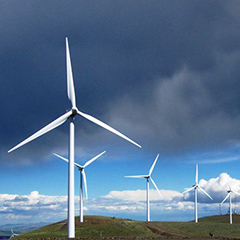A new Best Practice will be developed to improve the design of modern wind turbines and wind farms that will lead to cost reductions.
Copenhagen, Denmark –10 October 2016, Together with global partners, DNV GL, the world’s largest resource of independent energy experts and renewables certification body, has launched a Joint Industry Project (JIP) to develop a new Best Practice for the validation of turbulence models. The JIP “Validation of Turbulence Models” aims to create a better understanding of turbulence modelling to reduce uncertainty in the design of wind farms. By jointly developing guidelines in the form of a Best Practice document the project will improve accuracy on site-specific load assessments, leading to a reduction in the cost of wind energy.
To design wind turbines and wind farms, the industry currently relies on wind turbulence models that were developed decades ago when wind turbines were smaller than modern turbine types. With the increased size of wind turbines, current turbulence models result in large fatigue load variations with differences of up to 20%. Furthermore, existing turbulence models are often insufficiently applicable to other site-conditions beyond flat terrain and neutral stability.
By providing a platform to discuss challenges such as the most appropriate turbulence model parameters and whether parameters should differ onshore and offshore, stakeholders are developing a mutual alignment on key questions that are vital to moving the industry forward.
The JIP will collect onshore and offshore wind measurement data from more than 30 global sites, considering onshore, offshore and coastal influences in the analysis. By validating key turbulence parameters and evaluating their load impact, the JIP will provide guidance for optimal wind turbulence design and site assessments in a new Best Practice document.
The participants include a global range of wind farm developers, wind turbine manufactures and research institutes. The following companies are members of the project:
• Christian Michelsen Research AS
• DONG Energy Wind Power
• DTU Wind Energy
• Gamesa Innovation and Technology
• GE Global Research
• National Renewable Energy Laboratory (NREL)
• Siemens Wind Power AS
• SSE Renewables Developments LTD
• Statoil Petroleum AS
• Suzlon
• TechnoCentre Éolien
• Vattenfall AB
Kenneth Thomsen, Head of Section for Wind Turbine Loads and Control at DTU Wind Energy, has high expectations for the JIP project on turbulence. “In the design of wind turbines, the critical factor is often the wind inflow modelling, and often it is a challenge to model the wind and turbulence correctly at a specific site with only a limited amount of measured data. In this project, we aim to establish recommendations for using existing wind and turbulence models, but also for further development of these for future use.”
“Wind turbulence plays a major role in power production and loading on wind turbines. As a wind turbine manufacturer, this Joint Industry Project will help us create more reliable and cost effective designs, both at a wind turbine level and at a complete wind farm design level” says Enrique Gómez de las Heras, Loads & Dynamics Section Leader at Gamesa Innovation & Technology.
Jens Gjerding Chief Principal Specialist from Vattenfall commented on participation in the project: “With the requirement of reducing the cost of wind energy, it is necessary to improve our knowledge. Not only for reducing price/loads, but also to be sure that we are not too optimistic. Some subjects need more information than what is available at individual companies. The ‘Validation of Turbulence Model’ using data from many sources is the only way for further development.”
Jose Simon, Senior Engineer at DNV GL – Energy Renewables Certification, responsible for setting up this JIP commented: “In the planning process, it became apparent that there is currently area for improvement on turbulence modelling, especially for site-specific turbulence. Talking to different wind industry stakeholders during the preparation for this project highlighted the necessity of aligning industry expectations on turbulence in a Best Practice. To gain a deeper understanding of turbulence modelling the industry needs to collaborate and this project provides a unique platform to do so.”
Interested parties can still join the Joint Industry Project subjected to approval by the Steering Committee, please contact Mersudin Bajric via mersudin.bajric@dnvgl.com
About DNV GL
Driven by our purpose of safeguarding life, property and the environment, DNV GL enables organizations to advance the safety and sustainability of their business. We provide classification and technical assurance along with software and independent expert advisory services to the maritime, oil & gas and energy industries. We also provide certification services to customers across a wide range of industries. Operating in more than 100 countries, our professionals are dedicated to helping our customers make the world safer, smarter and greener.
DNV GL in the Energy industry
In DNV GL we unite the strengths of DNV, KEMA, Garrad Hassan, and GL Renewables Certification. DNV GL’s 2,500 energy experts support customers around the globe in delivering a safe, reliable, efficient, and sustainable energy supply. We deliver world-renowned testing, certification and advisory services to the energy value chain including renewables and energy efficiency. Our expertise spans onshore and offshore wind power, solar, conventional generation, transmission and distribution, smart grids, and sustainable energy use, as well as energy markets and regulations. Our testing, certification and advisory services are delivered independent from each other.
Learn more at www.dnvgl.com/energy


























